Individual Assignment on Taxation Law - LAWS20060, Term 2, 2019
VerifiedAdded on 2022/10/09
|19
|3678
|21
Homework Assignment
AI Summary
This taxation law assignment provides a detailed analysis of several key concepts within Australian taxation law. The assignment addresses various requirements, including the interpretation of 'small business entity' under the Income Tax Assessment Act, deductions for gifts, and the applicable tax rates for resident taxpayers. It explores the treatment of CGT assets, the implications of CGT events, and the tax-free threshold. The assignment also delves into the differences between ordinary and statutory income, as well as Medicare Levy and Medicare Levy Surcharge. Furthermore, the assignment examines the interpretation of 'usual place of abode' and its distinction from 'permanent place of abode'. It also analyzes the deductibility of various expenses, such as HECS-HELP payments, travel costs, books, childcare, and clothing. Finally, the assignment covers CGT events and the granting of leases and the creation of options. The solutions are supported by references to relevant legislation, tax rulings, and case law, demonstrating a comprehensive understanding of the subject matter. This assignment is a valuable resource for students studying taxation law.
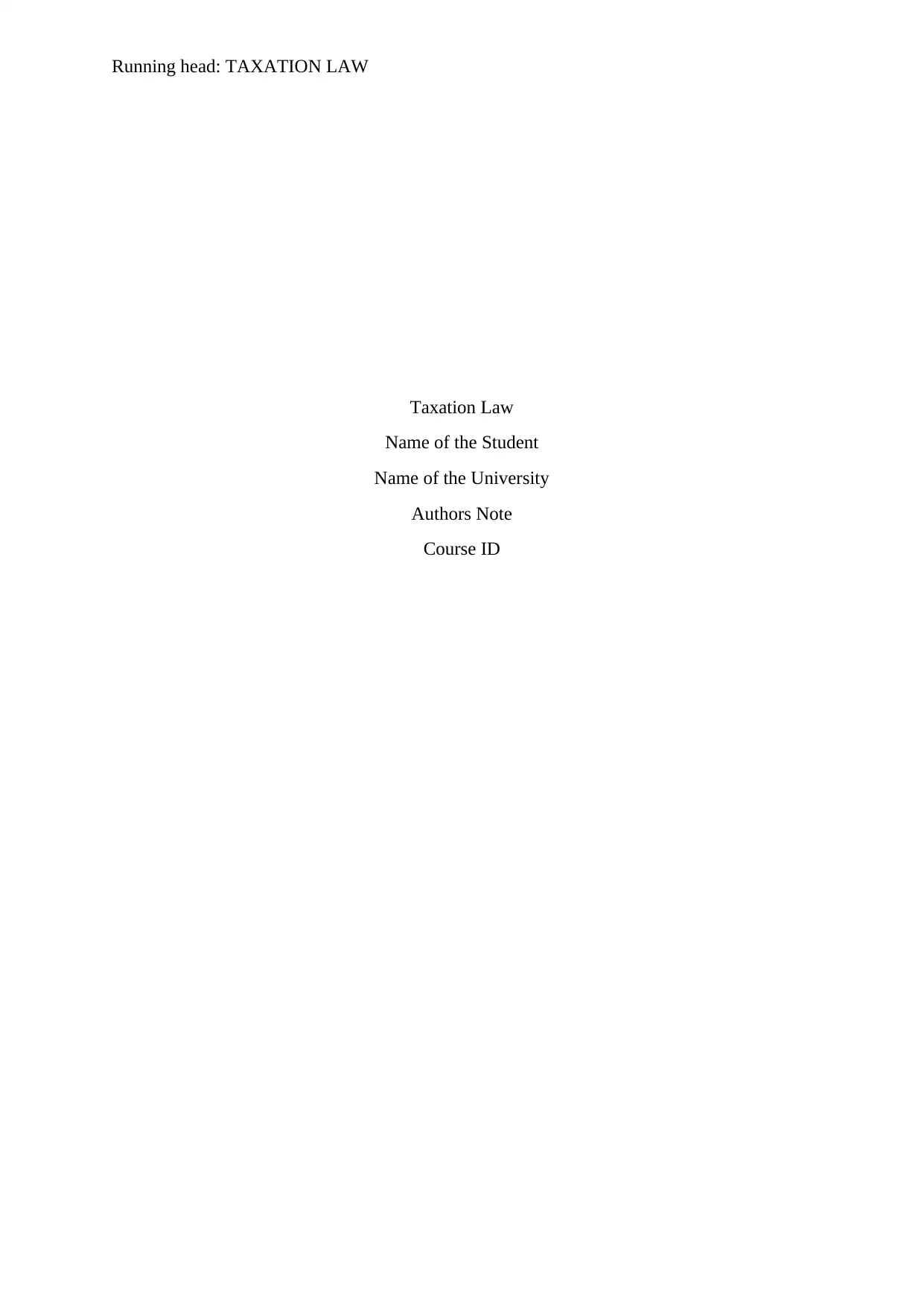
Running head: TAXATION LAW
Taxation Law
Name of the Student
Name of the University
Authors Note
Course ID
Taxation Law
Name of the Student
Name of the University
Authors Note
Course ID
Paraphrase This Document
Need a fresh take? Get an instant paraphrase of this document with our AI Paraphraser
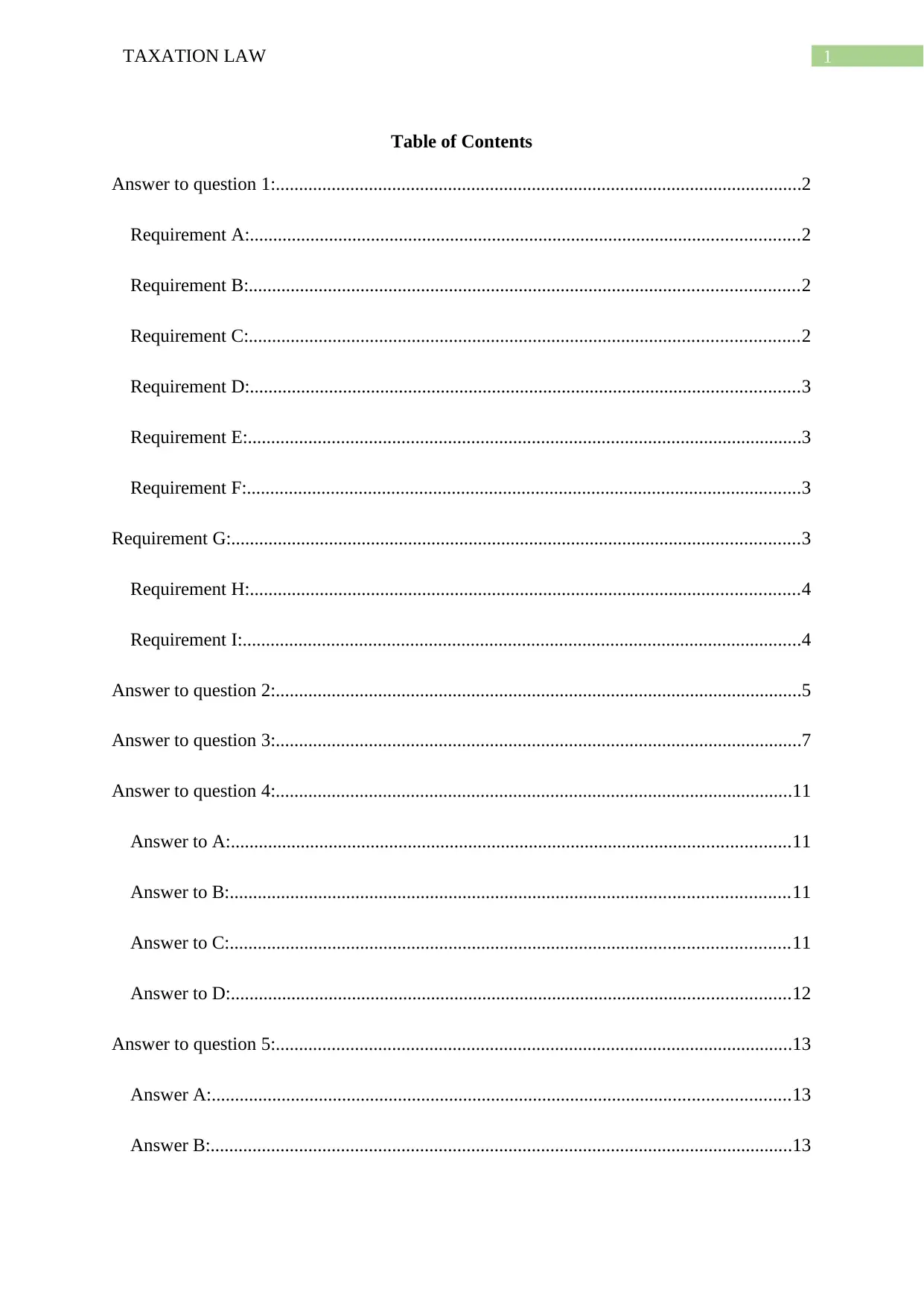
1TAXATION LAW
Table of Contents
Answer to question 1:.................................................................................................................2
Requirement A:......................................................................................................................2
Requirement B:......................................................................................................................2
Requirement C:......................................................................................................................2
Requirement D:......................................................................................................................3
Requirement E:.......................................................................................................................3
Requirement F:.......................................................................................................................3
Requirement G:..........................................................................................................................3
Requirement H:......................................................................................................................4
Requirement I:........................................................................................................................4
Answer to question 2:.................................................................................................................5
Answer to question 3:.................................................................................................................7
Answer to question 4:...............................................................................................................11
Answer to A:........................................................................................................................11
Answer to B:........................................................................................................................11
Answer to C:........................................................................................................................11
Answer to D:........................................................................................................................12
Answer to question 5:...............................................................................................................13
Answer A:............................................................................................................................13
Answer B:.............................................................................................................................13
Table of Contents
Answer to question 1:.................................................................................................................2
Requirement A:......................................................................................................................2
Requirement B:......................................................................................................................2
Requirement C:......................................................................................................................2
Requirement D:......................................................................................................................3
Requirement E:.......................................................................................................................3
Requirement F:.......................................................................................................................3
Requirement G:..........................................................................................................................3
Requirement H:......................................................................................................................4
Requirement I:........................................................................................................................4
Answer to question 2:.................................................................................................................5
Answer to question 3:.................................................................................................................7
Answer to question 4:...............................................................................................................11
Answer to A:........................................................................................................................11
Answer to B:........................................................................................................................11
Answer to C:........................................................................................................................11
Answer to D:........................................................................................................................12
Answer to question 5:...............................................................................................................13
Answer A:............................................................................................................................13
Answer B:.............................................................................................................................13
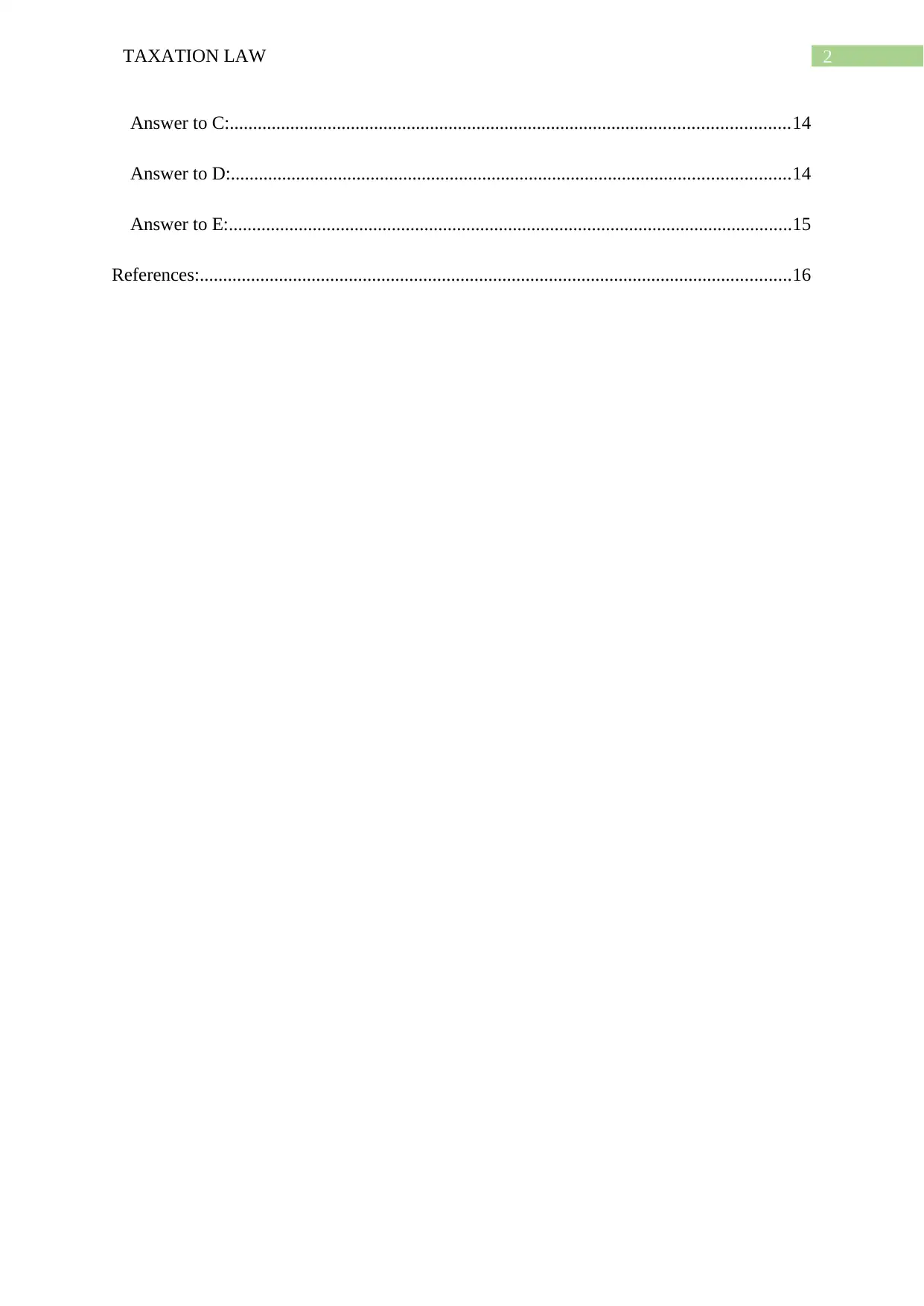
2TAXATION LAW
Answer to C:........................................................................................................................14
Answer to D:........................................................................................................................14
Answer to E:.........................................................................................................................15
References:...............................................................................................................................16
Answer to C:........................................................................................................................14
Answer to D:........................................................................................................................14
Answer to E:.........................................................................................................................15
References:...............................................................................................................................16
⊘ This is a preview!⊘
Do you want full access?
Subscribe today to unlock all pages.

Trusted by 1+ million students worldwide
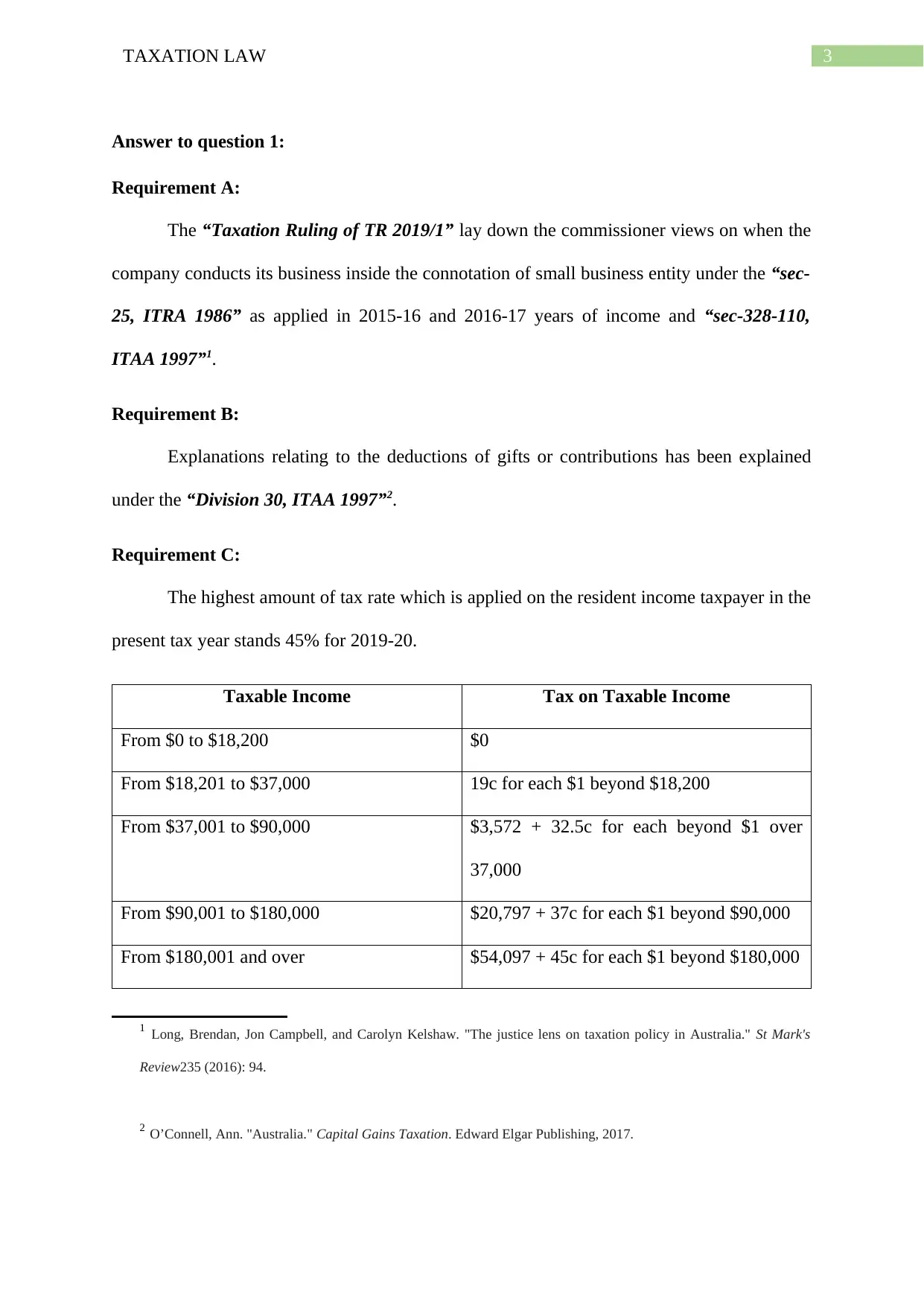
3TAXATION LAW
Answer to question 1:
Requirement A:
The “Taxation Ruling of TR 2019/1” lay down the commissioner views on when the
company conducts its business inside the connotation of small business entity under the “sec-
25, ITRA 1986” as applied in 2015-16 and 2016-17 years of income and “sec-328-110,
ITAA 1997”1.
Requirement B:
Explanations relating to the deductions of gifts or contributions has been explained
under the “Division 30, ITAA 1997”2.
Requirement C:
The highest amount of tax rate which is applied on the resident income taxpayer in the
present tax year stands 45% for 2019-20.
Taxable Income Tax on Taxable Income
From $0 to $18,200 $0
From $18,201 to $37,000 19c for each $1 beyond $18,200
From $37,001 to $90,000 $3,572 + 32.5c for each beyond $1 over
37,000
From $90,001 to $180,000 $20,797 + 37c for each $1 beyond $90,000
From $180,001 and over $54,097 + 45c for each $1 beyond $180,000
1 Long, Brendan, Jon Campbell, and Carolyn Kelshaw. "The justice lens on taxation policy in Australia." St Mark's
Review235 (2016): 94.
2 O’Connell, Ann. "Australia." Capital Gains Taxation. Edward Elgar Publishing, 2017.
Answer to question 1:
Requirement A:
The “Taxation Ruling of TR 2019/1” lay down the commissioner views on when the
company conducts its business inside the connotation of small business entity under the “sec-
25, ITRA 1986” as applied in 2015-16 and 2016-17 years of income and “sec-328-110,
ITAA 1997”1.
Requirement B:
Explanations relating to the deductions of gifts or contributions has been explained
under the “Division 30, ITAA 1997”2.
Requirement C:
The highest amount of tax rate which is applied on the resident income taxpayer in the
present tax year stands 45% for 2019-20.
Taxable Income Tax on Taxable Income
From $0 to $18,200 $0
From $18,201 to $37,000 19c for each $1 beyond $18,200
From $37,001 to $90,000 $3,572 + 32.5c for each beyond $1 over
37,000
From $90,001 to $180,000 $20,797 + 37c for each $1 beyond $90,000
From $180,001 and over $54,097 + 45c for each $1 beyond $180,000
1 Long, Brendan, Jon Campbell, and Carolyn Kelshaw. "The justice lens on taxation policy in Australia." St Mark's
Review235 (2016): 94.
2 O’Connell, Ann. "Australia." Capital Gains Taxation. Edward Elgar Publishing, 2017.
Paraphrase This Document
Need a fresh take? Get an instant paraphrase of this document with our AI Paraphraser
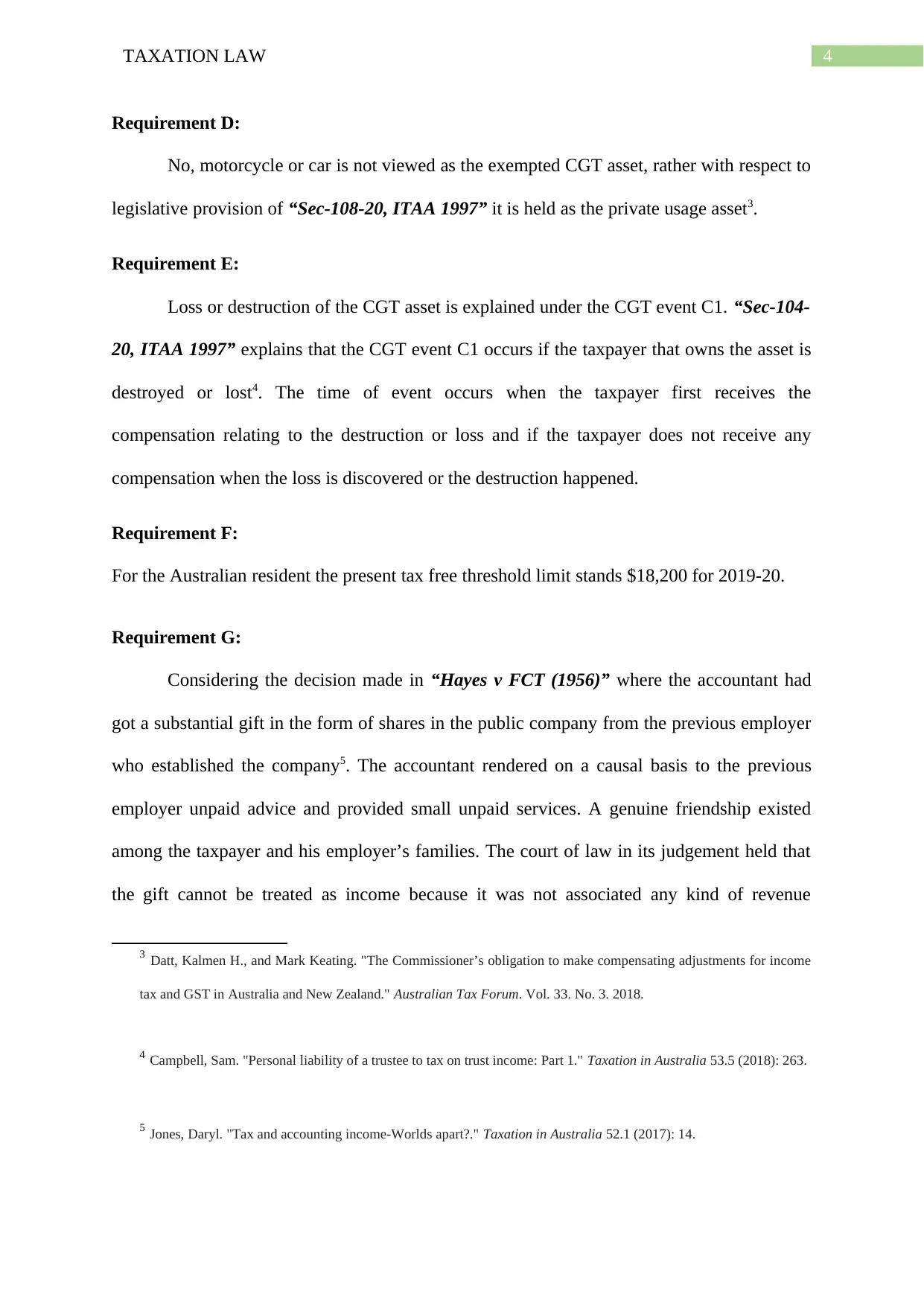
4TAXATION LAW
Requirement D:
No, motorcycle or car is not viewed as the exempted CGT asset, rather with respect to
legislative provision of “Sec-108-20, ITAA 1997” it is held as the private usage asset3.
Requirement E:
Loss or destruction of the CGT asset is explained under the CGT event C1. “Sec-104-
20, ITAA 1997” explains that the CGT event C1 occurs if the taxpayer that owns the asset is
destroyed or lost4. The time of event occurs when the taxpayer first receives the
compensation relating to the destruction or loss and if the taxpayer does not receive any
compensation when the loss is discovered or the destruction happened.
Requirement F:
For the Australian resident the present tax free threshold limit stands $18,200 for 2019-20.
Requirement G:
Considering the decision made in “Hayes v FCT (1956)” where the accountant had
got a substantial gift in the form of shares in the public company from the previous employer
who established the company5. The accountant rendered on a causal basis to the previous
employer unpaid advice and provided small unpaid services. A genuine friendship existed
among the taxpayer and his employer’s families. The court of law in its judgement held that
the gift cannot be treated as income because it was not associated any kind of revenue
3 Datt, Kalmen H., and Mark Keating. "The Commissioner’s obligation to make compensating adjustments for income
tax and GST in Australia and New Zealand." Australian Tax Forum. Vol. 33. No. 3. 2018.
4 Campbell, Sam. "Personal liability of a trustee to tax on trust income: Part 1." Taxation in Australia 53.5 (2018): 263.
5 Jones, Daryl. "Tax and accounting income-Worlds apart?." Taxation in Australia 52.1 (2017): 14.
Requirement D:
No, motorcycle or car is not viewed as the exempted CGT asset, rather with respect to
legislative provision of “Sec-108-20, ITAA 1997” it is held as the private usage asset3.
Requirement E:
Loss or destruction of the CGT asset is explained under the CGT event C1. “Sec-104-
20, ITAA 1997” explains that the CGT event C1 occurs if the taxpayer that owns the asset is
destroyed or lost4. The time of event occurs when the taxpayer first receives the
compensation relating to the destruction or loss and if the taxpayer does not receive any
compensation when the loss is discovered or the destruction happened.
Requirement F:
For the Australian resident the present tax free threshold limit stands $18,200 for 2019-20.
Requirement G:
Considering the decision made in “Hayes v FCT (1956)” where the accountant had
got a substantial gift in the form of shares in the public company from the previous employer
who established the company5. The accountant rendered on a causal basis to the previous
employer unpaid advice and provided small unpaid services. A genuine friendship existed
among the taxpayer and his employer’s families. The court of law in its judgement held that
the gift cannot be treated as income because it was not associated any kind of revenue
3 Datt, Kalmen H., and Mark Keating. "The Commissioner’s obligation to make compensating adjustments for income
tax and GST in Australia and New Zealand." Australian Tax Forum. Vol. 33. No. 3. 2018.
4 Campbell, Sam. "Personal liability of a trustee to tax on trust income: Part 1." Taxation in Australia 53.5 (2018): 263.
5 Jones, Daryl. "Tax and accounting income-Worlds apart?." Taxation in Australia 52.1 (2017): 14.
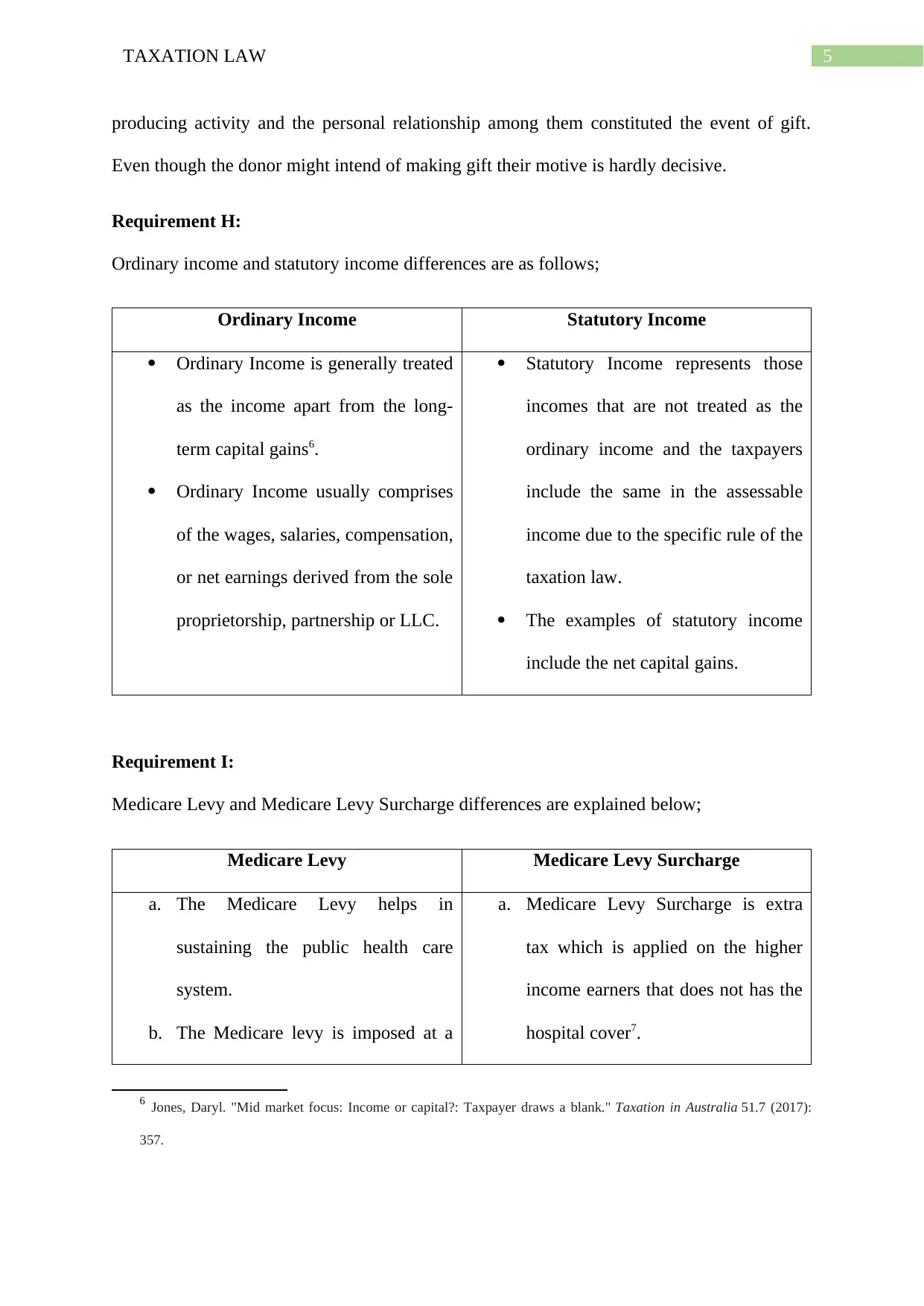
5TAXATION LAW
producing activity and the personal relationship among them constituted the event of gift.
Even though the donor might intend of making gift their motive is hardly decisive.
Requirement H:
Ordinary income and statutory income differences are as follows;
Ordinary Income Statutory Income
Ordinary Income is generally treated
as the income apart from the long-
term capital gains6.
Ordinary Income usually comprises
of the wages, salaries, compensation,
or net earnings derived from the sole
proprietorship, partnership or LLC.
Statutory Income represents those
incomes that are not treated as the
ordinary income and the taxpayers
include the same in the assessable
income due to the specific rule of the
taxation law.
The examples of statutory income
include the net capital gains.
Requirement I:
Medicare Levy and Medicare Levy Surcharge differences are explained below;
Medicare Levy Medicare Levy Surcharge
a. The Medicare Levy helps in
sustaining the public health care
system.
b. The Medicare levy is imposed at a
a. Medicare Levy Surcharge is extra
tax which is applied on the higher
income earners that does not has the
hospital cover7.
6 Jones, Daryl. "Mid market focus: Income or capital?: Taxpayer draws a blank." Taxation in Australia 51.7 (2017):
357.
producing activity and the personal relationship among them constituted the event of gift.
Even though the donor might intend of making gift their motive is hardly decisive.
Requirement H:
Ordinary income and statutory income differences are as follows;
Ordinary Income Statutory Income
Ordinary Income is generally treated
as the income apart from the long-
term capital gains6.
Ordinary Income usually comprises
of the wages, salaries, compensation,
or net earnings derived from the sole
proprietorship, partnership or LLC.
Statutory Income represents those
incomes that are not treated as the
ordinary income and the taxpayers
include the same in the assessable
income due to the specific rule of the
taxation law.
The examples of statutory income
include the net capital gains.
Requirement I:
Medicare Levy and Medicare Levy Surcharge differences are explained below;
Medicare Levy Medicare Levy Surcharge
a. The Medicare Levy helps in
sustaining the public health care
system.
b. The Medicare levy is imposed at a
a. Medicare Levy Surcharge is extra
tax which is applied on the higher
income earners that does not has the
hospital cover7.
6 Jones, Daryl. "Mid market focus: Income or capital?: Taxpayer draws a blank." Taxation in Australia 51.7 (2017):
357.
⊘ This is a preview!⊘
Do you want full access?
Subscribe today to unlock all pages.

Trusted by 1+ million students worldwide
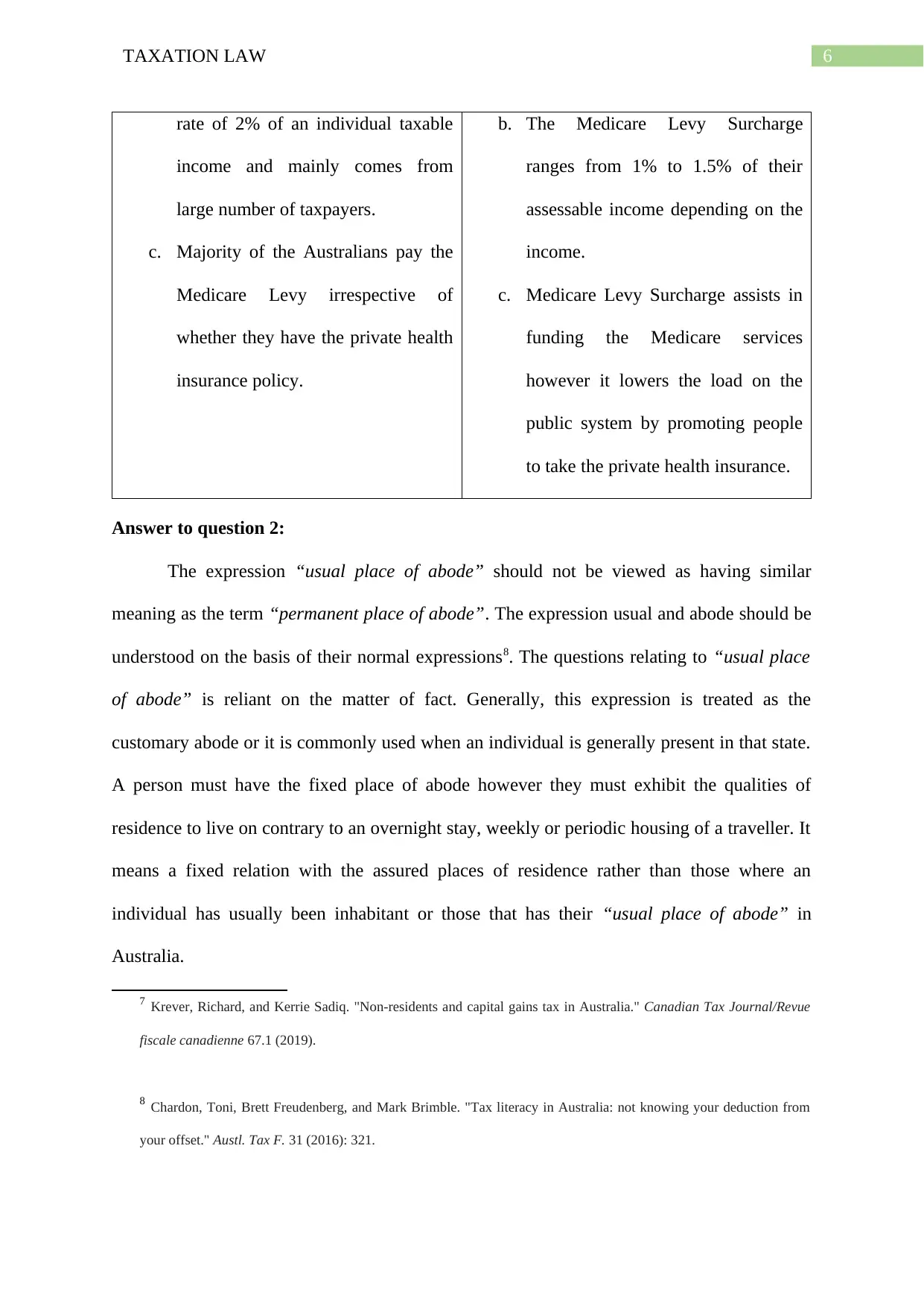
6TAXATION LAW
rate of 2% of an individual taxable
income and mainly comes from
large number of taxpayers.
c. Majority of the Australians pay the
Medicare Levy irrespective of
whether they have the private health
insurance policy.
b. The Medicare Levy Surcharge
ranges from 1% to 1.5% of their
assessable income depending on the
income.
c. Medicare Levy Surcharge assists in
funding the Medicare services
however it lowers the load on the
public system by promoting people
to take the private health insurance.
Answer to question 2:
The expression “usual place of abode” should not be viewed as having similar
meaning as the term “permanent place of abode”. The expression usual and abode should be
understood on the basis of their normal expressions8. The questions relating to “usual place
of abode” is reliant on the matter of fact. Generally, this expression is treated as the
customary abode or it is commonly used when an individual is generally present in that state.
A person must have the fixed place of abode however they must exhibit the qualities of
residence to live on contrary to an overnight stay, weekly or periodic housing of a traveller. It
means a fixed relation with the assured places of residence rather than those where an
individual has usually been inhabitant or those that has their “usual place of abode” in
Australia.
7 Krever, Richard, and Kerrie Sadiq. "Non-residents and capital gains tax in Australia." Canadian Tax Journal/Revue
fiscale canadienne 67.1 (2019).
8 Chardon, Toni, Brett Freudenberg, and Mark Brimble. "Tax literacy in Australia: not knowing your deduction from
your offset." Austl. Tax F. 31 (2016): 321.
rate of 2% of an individual taxable
income and mainly comes from
large number of taxpayers.
c. Majority of the Australians pay the
Medicare Levy irrespective of
whether they have the private health
insurance policy.
b. The Medicare Levy Surcharge
ranges from 1% to 1.5% of their
assessable income depending on the
income.
c. Medicare Levy Surcharge assists in
funding the Medicare services
however it lowers the load on the
public system by promoting people
to take the private health insurance.
Answer to question 2:
The expression “usual place of abode” should not be viewed as having similar
meaning as the term “permanent place of abode”. The expression usual and abode should be
understood on the basis of their normal expressions8. The questions relating to “usual place
of abode” is reliant on the matter of fact. Generally, this expression is treated as the
customary abode or it is commonly used when an individual is generally present in that state.
A person must have the fixed place of abode however they must exhibit the qualities of
residence to live on contrary to an overnight stay, weekly or periodic housing of a traveller. It
means a fixed relation with the assured places of residence rather than those where an
individual has usually been inhabitant or those that has their “usual place of abode” in
Australia.
7 Krever, Richard, and Kerrie Sadiq. "Non-residents and capital gains tax in Australia." Canadian Tax Journal/Revue
fiscale canadienne 67.1 (2019).
8 Chardon, Toni, Brett Freudenberg, and Mark Brimble. "Tax literacy in Australia: not knowing your deduction from
your offset." Austl. Tax F. 31 (2016): 321.
Paraphrase This Document
Need a fresh take? Get an instant paraphrase of this document with our AI Paraphraser
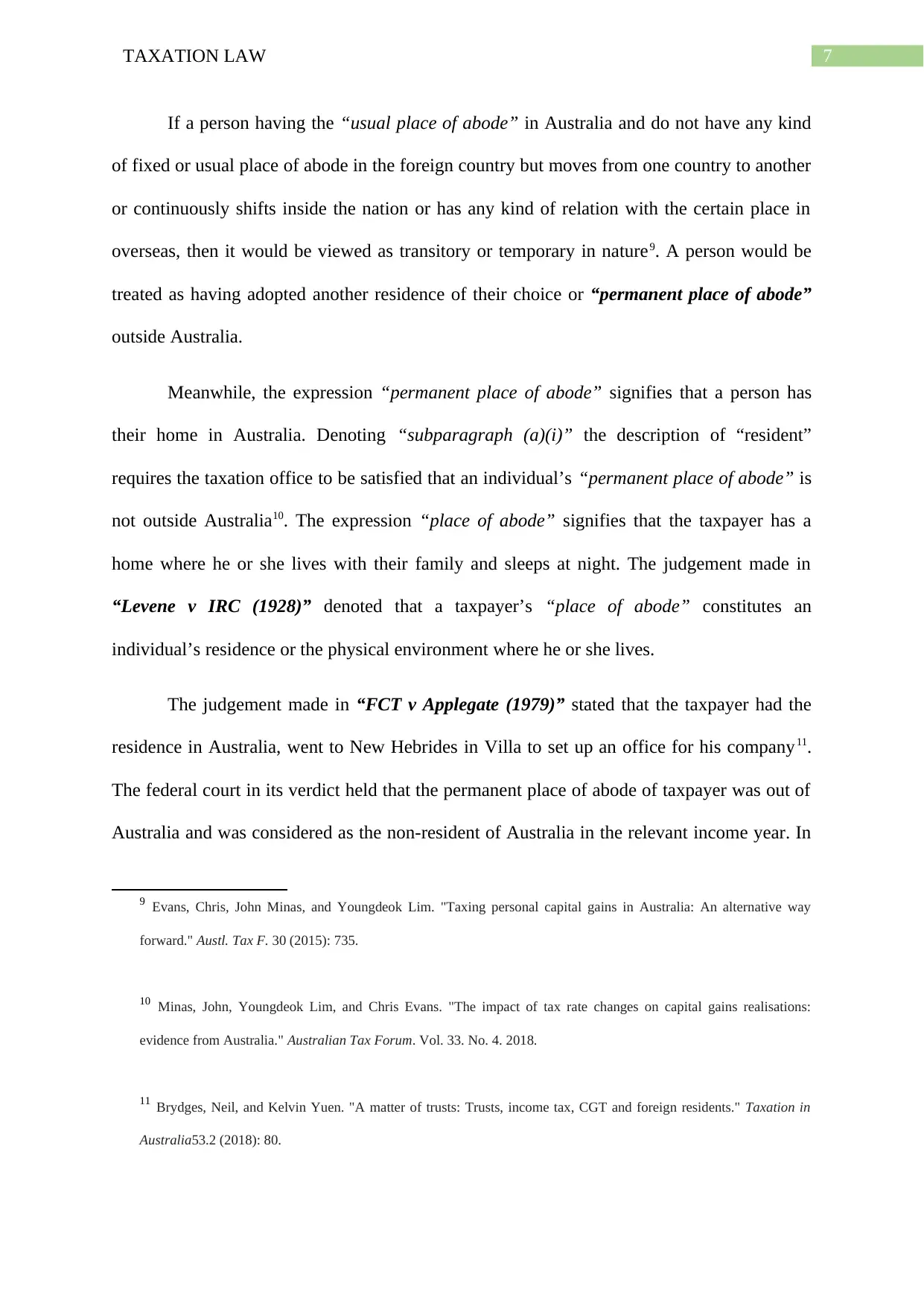
7TAXATION LAW
If a person having the “usual place of abode” in Australia and do not have any kind
of fixed or usual place of abode in the foreign country but moves from one country to another
or continuously shifts inside the nation or has any kind of relation with the certain place in
overseas, then it would be viewed as transitory or temporary in nature9. A person would be
treated as having adopted another residence of their choice or “permanent place of abode”
outside Australia.
Meanwhile, the expression “permanent place of abode” signifies that a person has
their home in Australia. Denoting “subparagraph (a)(i)” the description of “resident”
requires the taxation office to be satisfied that an individual’s “permanent place of abode” is
not outside Australia10. The expression “place of abode” signifies that the taxpayer has a
home where he or she lives with their family and sleeps at night. The judgement made in
“Levene v IRC (1928)” denoted that a taxpayer’s “place of abode” constitutes an
individual’s residence or the physical environment where he or she lives.
The judgement made in “FCT v Applegate (1979)” stated that the taxpayer had the
residence in Australia, went to New Hebrides in Villa to set up an office for his company11.
The federal court in its verdict held that the permanent place of abode of taxpayer was out of
Australia and was considered as the non-resident of Australia in the relevant income year. In
9 Evans, Chris, John Minas, and Youngdeok Lim. "Taxing personal capital gains in Australia: An alternative way
forward." Austl. Tax F. 30 (2015): 735.
10 Minas, John, Youngdeok Lim, and Chris Evans. "The impact of tax rate changes on capital gains realisations:
evidence from Australia." Australian Tax Forum. Vol. 33. No. 4. 2018.
11 Brydges, Neil, and Kelvin Yuen. "A matter of trusts: Trusts, income tax, CGT and foreign residents." Taxation in
Australia53.2 (2018): 80.
If a person having the “usual place of abode” in Australia and do not have any kind
of fixed or usual place of abode in the foreign country but moves from one country to another
or continuously shifts inside the nation or has any kind of relation with the certain place in
overseas, then it would be viewed as transitory or temporary in nature9. A person would be
treated as having adopted another residence of their choice or “permanent place of abode”
outside Australia.
Meanwhile, the expression “permanent place of abode” signifies that a person has
their home in Australia. Denoting “subparagraph (a)(i)” the description of “resident”
requires the taxation office to be satisfied that an individual’s “permanent place of abode” is
not outside Australia10. The expression “place of abode” signifies that the taxpayer has a
home where he or she lives with their family and sleeps at night. The judgement made in
“Levene v IRC (1928)” denoted that a taxpayer’s “place of abode” constitutes an
individual’s residence or the physical environment where he or she lives.
The judgement made in “FCT v Applegate (1979)” stated that the taxpayer had the
residence in Australia, went to New Hebrides in Villa to set up an office for his company11.
The federal court in its verdict held that the permanent place of abode of taxpayer was out of
Australia and was considered as the non-resident of Australia in the relevant income year. In
9 Evans, Chris, John Minas, and Youngdeok Lim. "Taxing personal capital gains in Australia: An alternative way
forward." Austl. Tax F. 30 (2015): 735.
10 Minas, John, Youngdeok Lim, and Chris Evans. "The impact of tax rate changes on capital gains realisations:
evidence from Australia." Australian Tax Forum. Vol. 33. No. 4. 2018.
11 Brydges, Neil, and Kelvin Yuen. "A matter of trusts: Trusts, income tax, CGT and foreign residents." Taxation in
Australia53.2 (2018): 80.
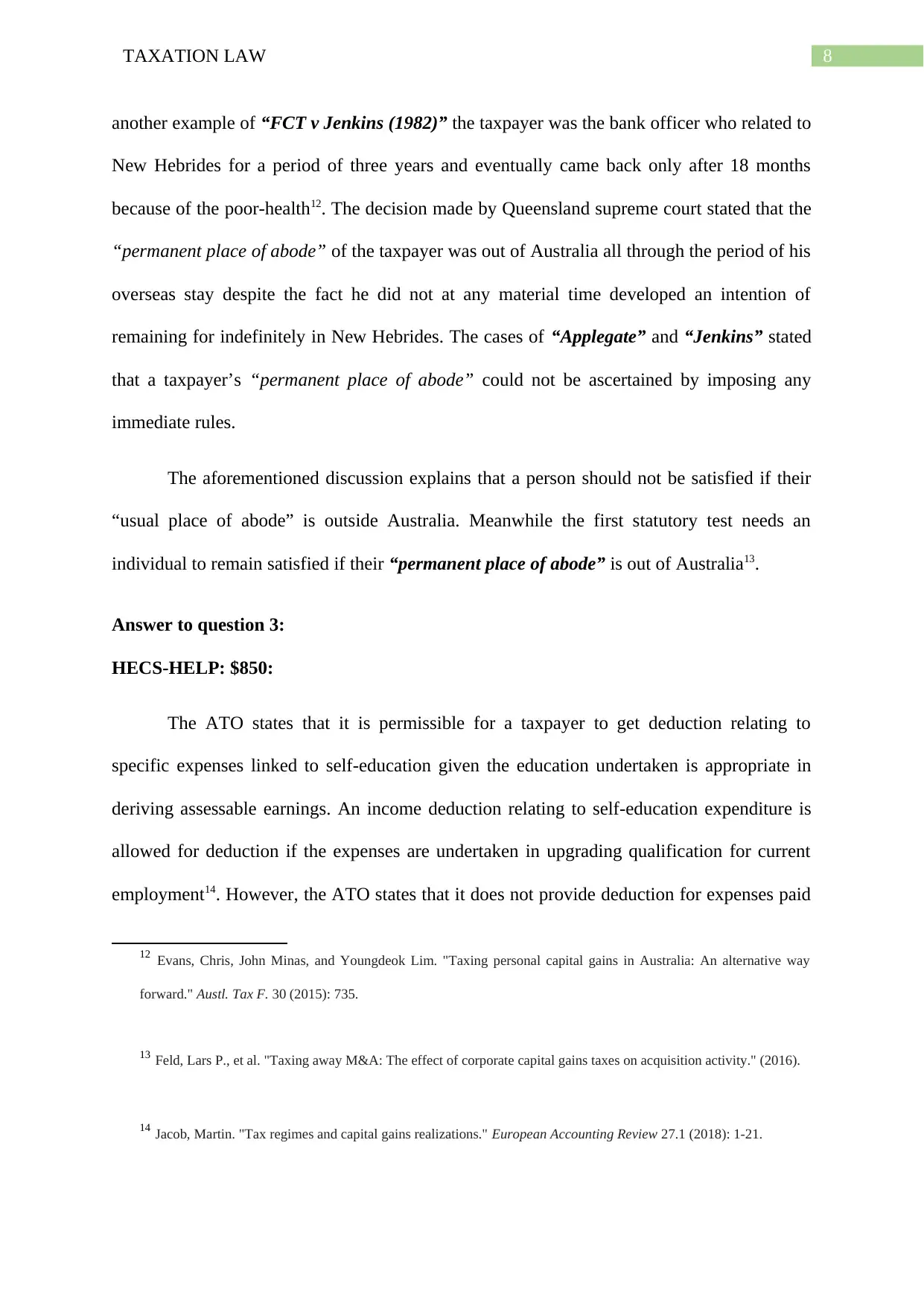
8TAXATION LAW
another example of “FCT v Jenkins (1982)” the taxpayer was the bank officer who related to
New Hebrides for a period of three years and eventually came back only after 18 months
because of the poor-health12. The decision made by Queensland supreme court stated that the
“permanent place of abode” of the taxpayer was out of Australia all through the period of his
overseas stay despite the fact he did not at any material time developed an intention of
remaining for indefinitely in New Hebrides. The cases of “Applegate” and “Jenkins” stated
that a taxpayer’s “permanent place of abode” could not be ascertained by imposing any
immediate rules.
The aforementioned discussion explains that a person should not be satisfied if their
“usual place of abode” is outside Australia. Meanwhile the first statutory test needs an
individual to remain satisfied if their “permanent place of abode” is out of Australia13.
Answer to question 3:
HECS-HELP: $850:
The ATO states that it is permissible for a taxpayer to get deduction relating to
specific expenses linked to self-education given the education undertaken is appropriate in
deriving assessable earnings. An income deduction relating to self-education expenditure is
allowed for deduction if the expenses are undertaken in upgrading qualification for current
employment14. However, the ATO states that it does not provide deduction for expenses paid
12 Evans, Chris, John Minas, and Youngdeok Lim. "Taxing personal capital gains in Australia: An alternative way
forward." Austl. Tax F. 30 (2015): 735.
13 Feld, Lars P., et al. "Taxing away M&A: The effect of corporate capital gains taxes on acquisition activity." (2016).
14 Jacob, Martin. "Tax regimes and capital gains realizations." European Accounting Review 27.1 (2018): 1-21.
another example of “FCT v Jenkins (1982)” the taxpayer was the bank officer who related to
New Hebrides for a period of three years and eventually came back only after 18 months
because of the poor-health12. The decision made by Queensland supreme court stated that the
“permanent place of abode” of the taxpayer was out of Australia all through the period of his
overseas stay despite the fact he did not at any material time developed an intention of
remaining for indefinitely in New Hebrides. The cases of “Applegate” and “Jenkins” stated
that a taxpayer’s “permanent place of abode” could not be ascertained by imposing any
immediate rules.
The aforementioned discussion explains that a person should not be satisfied if their
“usual place of abode” is outside Australia. Meanwhile the first statutory test needs an
individual to remain satisfied if their “permanent place of abode” is out of Australia13.
Answer to question 3:
HECS-HELP: $850:
The ATO states that it is permissible for a taxpayer to get deduction relating to
specific expenses linked to self-education given the education undertaken is appropriate in
deriving assessable earnings. An income deduction relating to self-education expenditure is
allowed for deduction if the expenses are undertaken in upgrading qualification for current
employment14. However, the ATO states that it does not provide deduction for expenses paid
12 Evans, Chris, John Minas, and Youngdeok Lim. "Taxing personal capital gains in Australia: An alternative way
forward." Austl. Tax F. 30 (2015): 735.
13 Feld, Lars P., et al. "Taxing away M&A: The effect of corporate capital gains taxes on acquisition activity." (2016).
14 Jacob, Martin. "Tax regimes and capital gains realizations." European Accounting Review 27.1 (2018): 1-21.
⊘ This is a preview!⊘
Do you want full access?
Subscribe today to unlock all pages.

Trusted by 1+ million students worldwide
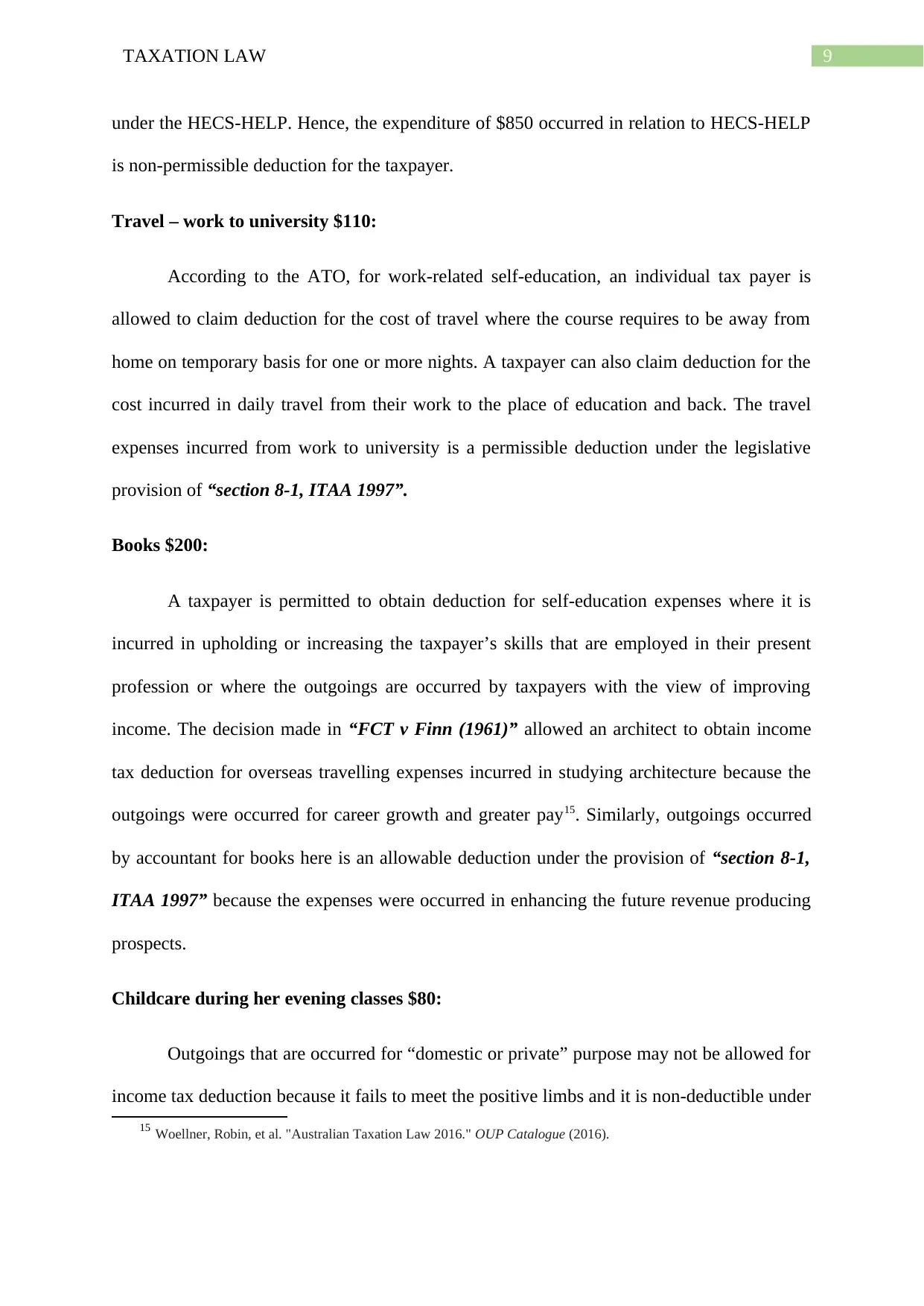
9TAXATION LAW
under the HECS-HELP. Hence, the expenditure of $850 occurred in relation to HECS-HELP
is non-permissible deduction for the taxpayer.
Travel – work to university $110:
According to the ATO, for work-related self-education, an individual tax payer is
allowed to claim deduction for the cost of travel where the course requires to be away from
home on temporary basis for one or more nights. A taxpayer can also claim deduction for the
cost incurred in daily travel from their work to the place of education and back. The travel
expenses incurred from work to university is a permissible deduction under the legislative
provision of “section 8-1, ITAA 1997”.
Books $200:
A taxpayer is permitted to obtain deduction for self-education expenses where it is
incurred in upholding or increasing the taxpayer’s skills that are employed in their present
profession or where the outgoings are occurred by taxpayers with the view of improving
income. The decision made in “FCT v Finn (1961)” allowed an architect to obtain income
tax deduction for overseas travelling expenses incurred in studying architecture because the
outgoings were occurred for career growth and greater pay15. Similarly, outgoings occurred
by accountant for books here is an allowable deduction under the provision of “section 8-1,
ITAA 1997” because the expenses were occurred in enhancing the future revenue producing
prospects.
Childcare during her evening classes $80:
Outgoings that are occurred for “domestic or private” purpose may not be allowed for
income tax deduction because it fails to meet the positive limbs and it is non-deductible under
15 Woellner, Robin, et al. "Australian Taxation Law 2016." OUP Catalogue (2016).
under the HECS-HELP. Hence, the expenditure of $850 occurred in relation to HECS-HELP
is non-permissible deduction for the taxpayer.
Travel – work to university $110:
According to the ATO, for work-related self-education, an individual tax payer is
allowed to claim deduction for the cost of travel where the course requires to be away from
home on temporary basis for one or more nights. A taxpayer can also claim deduction for the
cost incurred in daily travel from their work to the place of education and back. The travel
expenses incurred from work to university is a permissible deduction under the legislative
provision of “section 8-1, ITAA 1997”.
Books $200:
A taxpayer is permitted to obtain deduction for self-education expenses where it is
incurred in upholding or increasing the taxpayer’s skills that are employed in their present
profession or where the outgoings are occurred by taxpayers with the view of improving
income. The decision made in “FCT v Finn (1961)” allowed an architect to obtain income
tax deduction for overseas travelling expenses incurred in studying architecture because the
outgoings were occurred for career growth and greater pay15. Similarly, outgoings occurred
by accountant for books here is an allowable deduction under the provision of “section 8-1,
ITAA 1997” because the expenses were occurred in enhancing the future revenue producing
prospects.
Childcare during her evening classes $80:
Outgoings that are occurred for “domestic or private” purpose may not be allowed for
income tax deduction because it fails to meet the positive limbs and it is non-deductible under
15 Woellner, Robin, et al. "Australian Taxation Law 2016." OUP Catalogue (2016).
Paraphrase This Document
Need a fresh take? Get an instant paraphrase of this document with our AI Paraphraser
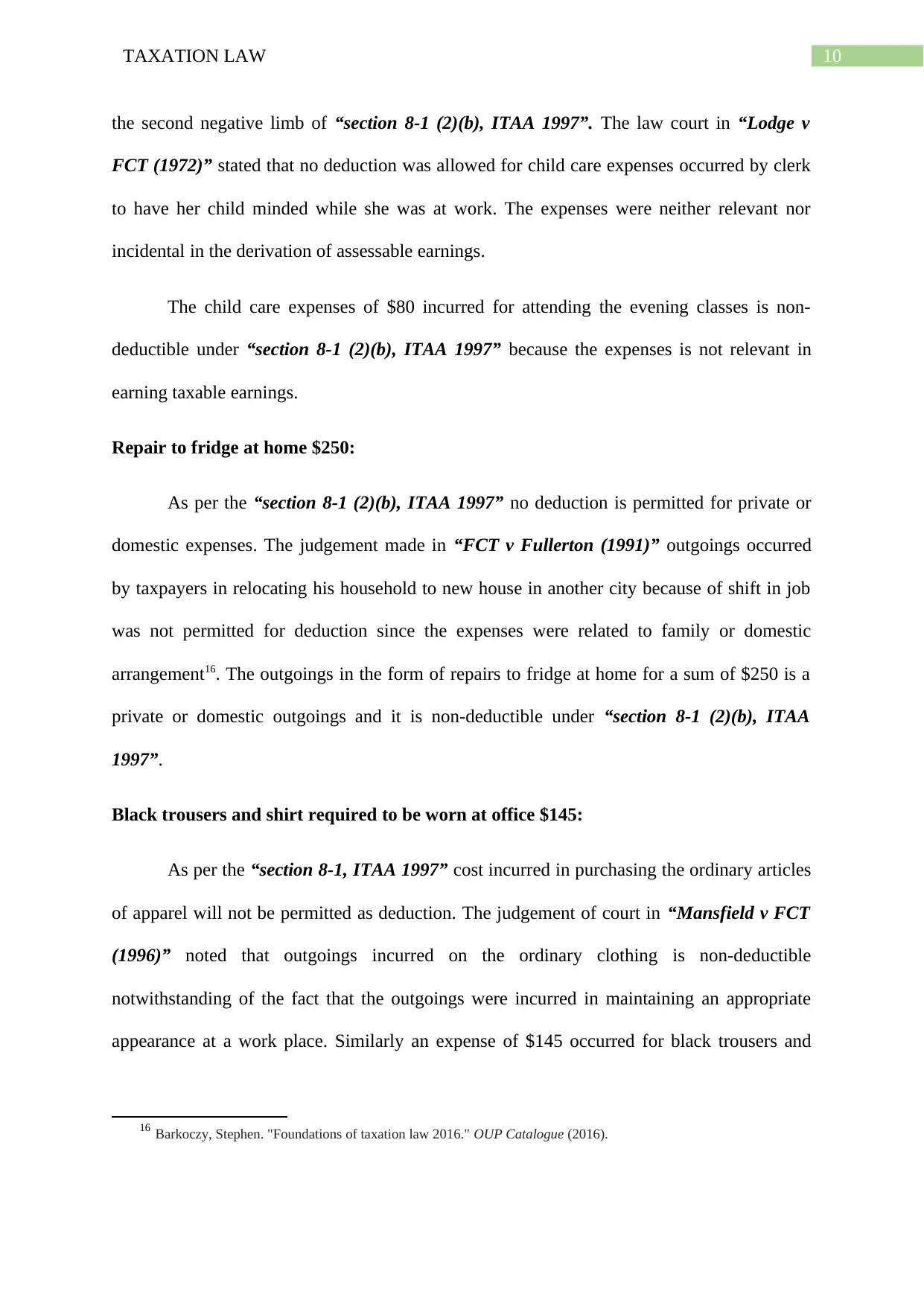
10TAXATION LAW
the second negative limb of “section 8-1 (2)(b), ITAA 1997”. The law court in “Lodge v
FCT (1972)” stated that no deduction was allowed for child care expenses occurred by clerk
to have her child minded while she was at work. The expenses were neither relevant nor
incidental in the derivation of assessable earnings.
The child care expenses of $80 incurred for attending the evening classes is non-
deductible under “section 8-1 (2)(b), ITAA 1997” because the expenses is not relevant in
earning taxable earnings.
Repair to fridge at home $250:
As per the “section 8-1 (2)(b), ITAA 1997” no deduction is permitted for private or
domestic expenses. The judgement made in “FCT v Fullerton (1991)” outgoings occurred
by taxpayers in relocating his household to new house in another city because of shift in job
was not permitted for deduction since the expenses were related to family or domestic
arrangement16. The outgoings in the form of repairs to fridge at home for a sum of $250 is a
private or domestic outgoings and it is non-deductible under “section 8-1 (2)(b), ITAA
1997”.
Black trousers and shirt required to be worn at office $145:
As per the “section 8-1, ITAA 1997” cost incurred in purchasing the ordinary articles
of apparel will not be permitted as deduction. The judgement of court in “Mansfield v FCT
(1996)” noted that outgoings incurred on the ordinary clothing is non-deductible
notwithstanding of the fact that the outgoings were incurred in maintaining an appropriate
appearance at a work place. Similarly an expense of $145 occurred for black trousers and
16 Barkoczy, Stephen. "Foundations of taxation law 2016." OUP Catalogue (2016).
the second negative limb of “section 8-1 (2)(b), ITAA 1997”. The law court in “Lodge v
FCT (1972)” stated that no deduction was allowed for child care expenses occurred by clerk
to have her child minded while she was at work. The expenses were neither relevant nor
incidental in the derivation of assessable earnings.
The child care expenses of $80 incurred for attending the evening classes is non-
deductible under “section 8-1 (2)(b), ITAA 1997” because the expenses is not relevant in
earning taxable earnings.
Repair to fridge at home $250:
As per the “section 8-1 (2)(b), ITAA 1997” no deduction is permitted for private or
domestic expenses. The judgement made in “FCT v Fullerton (1991)” outgoings occurred
by taxpayers in relocating his household to new house in another city because of shift in job
was not permitted for deduction since the expenses were related to family or domestic
arrangement16. The outgoings in the form of repairs to fridge at home for a sum of $250 is a
private or domestic outgoings and it is non-deductible under “section 8-1 (2)(b), ITAA
1997”.
Black trousers and shirt required to be worn at office $145:
As per the “section 8-1, ITAA 1997” cost incurred in purchasing the ordinary articles
of apparel will not be permitted as deduction. The judgement of court in “Mansfield v FCT
(1996)” noted that outgoings incurred on the ordinary clothing is non-deductible
notwithstanding of the fact that the outgoings were incurred in maintaining an appropriate
appearance at a work place. Similarly an expense of $145 occurred for black trousers and
16 Barkoczy, Stephen. "Foundations of taxation law 2016." OUP Catalogue (2016).
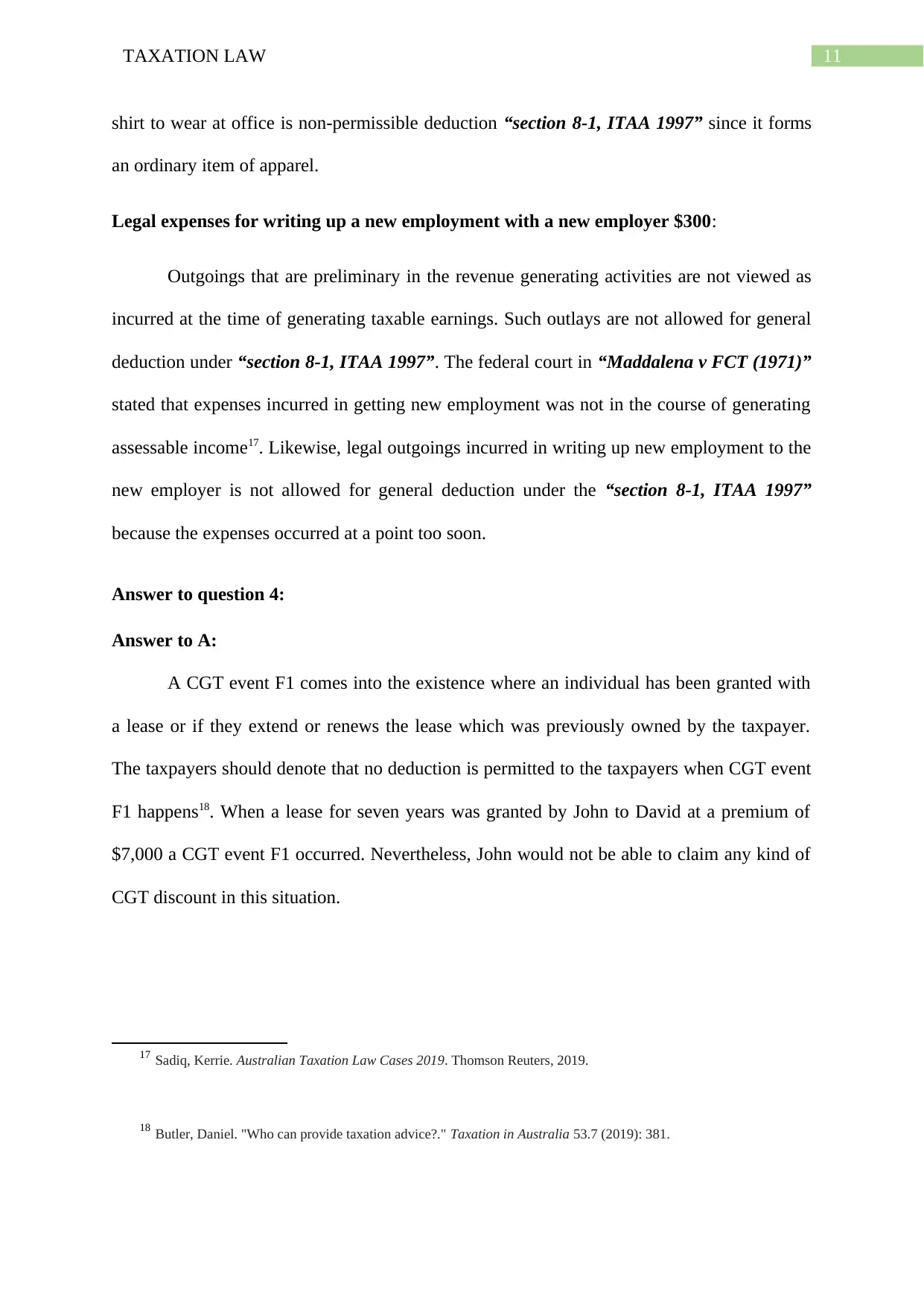
11TAXATION LAW
shirt to wear at office is non-permissible deduction “section 8-1, ITAA 1997” since it forms
an ordinary item of apparel.
Legal expenses for writing up a new employment with a new employer $300:
Outgoings that are preliminary in the revenue generating activities are not viewed as
incurred at the time of generating taxable earnings. Such outlays are not allowed for general
deduction under “section 8-1, ITAA 1997”. The federal court in “Maddalena v FCT (1971)”
stated that expenses incurred in getting new employment was not in the course of generating
assessable income17. Likewise, legal outgoings incurred in writing up new employment to the
new employer is not allowed for general deduction under the “section 8-1, ITAA 1997”
because the expenses occurred at a point too soon.
Answer to question 4:
Answer to A:
A CGT event F1 comes into the existence where an individual has been granted with
a lease or if they extend or renews the lease which was previously owned by the taxpayer.
The taxpayers should denote that no deduction is permitted to the taxpayers when CGT event
F1 happens18. When a lease for seven years was granted by John to David at a premium of
$7,000 a CGT event F1 occurred. Nevertheless, John would not be able to claim any kind of
CGT discount in this situation.
17 Sadiq, Kerrie. Australian Taxation Law Cases 2019. Thomson Reuters, 2019.
18 Butler, Daniel. "Who can provide taxation advice?." Taxation in Australia 53.7 (2019): 381.
shirt to wear at office is non-permissible deduction “section 8-1, ITAA 1997” since it forms
an ordinary item of apparel.
Legal expenses for writing up a new employment with a new employer $300:
Outgoings that are preliminary in the revenue generating activities are not viewed as
incurred at the time of generating taxable earnings. Such outlays are not allowed for general
deduction under “section 8-1, ITAA 1997”. The federal court in “Maddalena v FCT (1971)”
stated that expenses incurred in getting new employment was not in the course of generating
assessable income17. Likewise, legal outgoings incurred in writing up new employment to the
new employer is not allowed for general deduction under the “section 8-1, ITAA 1997”
because the expenses occurred at a point too soon.
Answer to question 4:
Answer to A:
A CGT event F1 comes into the existence where an individual has been granted with
a lease or if they extend or renews the lease which was previously owned by the taxpayer.
The taxpayers should denote that no deduction is permitted to the taxpayers when CGT event
F1 happens18. When a lease for seven years was granted by John to David at a premium of
$7,000 a CGT event F1 occurred. Nevertheless, John would not be able to claim any kind of
CGT discount in this situation.
17 Sadiq, Kerrie. Australian Taxation Law Cases 2019. Thomson Reuters, 2019.
18 Butler, Daniel. "Who can provide taxation advice?." Taxation in Australia 53.7 (2019): 381.
⊘ This is a preview!⊘
Do you want full access?
Subscribe today to unlock all pages.

Trusted by 1+ million students worldwide
1 out of 19
Related Documents
Your All-in-One AI-Powered Toolkit for Academic Success.
+13062052269
info@desklib.com
Available 24*7 on WhatsApp / Email
![[object Object]](/_next/static/media/star-bottom.7253800d.svg)
Unlock your academic potential
Copyright © 2020–2025 A2Z Services. All Rights Reserved. Developed and managed by ZUCOL.





